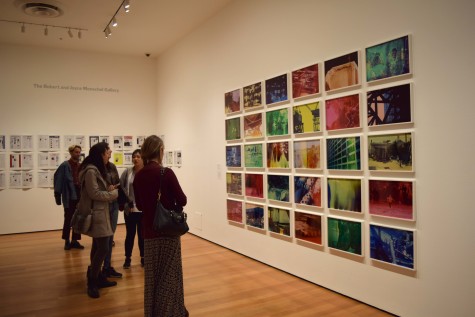MoMA’s ‘Ocean of Images’ explores uncharted photography techniques
November 10, 2015

Museum visitors look at Egyptian photographer Basim Magdy’s collection of chromogenic color prints called “The Hollow Desire to Populate Imaginary Cities.”
Exhibiting works from 19 artists and collectives from 14 countries, “Ocean of Images,” the Museum of Modern Art’s newest installation of “New Photography,” opened on Nov. 7. Due to its incredibly diverse nature, it’s only natural that some work shines brighter than others, with the best demonstrating insight and creativity while the worst is pretentious and forgettable
Much of the work in the exhibit is concerned with the changing role of photography in the increasingly technology-savvy world. As photography becomes more accessible to the masses, photographers must pioneer new ways to take photos. The photographs on exhibit were made using a great variety of techniques and have many different aims, using innovative techniques such as pulling from Google Earth, creating panoramic photomontages and layering shots. Some photos are very emotional, while others are formal exercises or political statements. Many seek to make statements about photography itself.
Of all the works in the exhibit, Lieko Shiga’s is the most moving. Born in Japan, Shiga portrays people in an ordinary town before and after it was struck by a tsunami in 2011. Unlike most of the photographers featured in the exhibition, Shiga utilizes human subjects. He starts with fairly typical shots of his subjects at work or on the beach and then manipulates the color to make images that are memorably eerie and distant. One shows a man running across a wide open beach as a red sky lays above him, turning an upbeat, visual cliche on its head.
Equally interesting, although less personal, are the photographs of John Houck. His five pictures on display all feature common office equipment organized into extremely neat patterns. Things as unremarkable as stamps and graphing paper are examined in terms of their color and shape. Like much good photography, Houck makes the viewer aware of the beauty of things that are often taken for granted.
Often in the exhibit, the most ambitious art is the least successful. The U.S. art collective DIS is a prime example. Their work, which includes photography and several digital installations, tries to satirize the U.S. media’s idea of beauty. In one photograph a family wears makeup symbolizing all the ways that images of family are cleaned up for presentation on television. Images like this from DIS are not very clever as social criticism and very uninspiring as photography.
Other work is unsuccessful because it does not seem to be aiming for anything more than novelty. Israeli photographer Ilit Azoulay has nearly one hundred images taken in Germany, but there is nothing unifying them. Indrė Šerpytytė, who studied photography in London, photographs wood models of houses that were used by the government for torture in her native Lithuania, but this seems like an empty gimmick.
If there is one thing that all the photography in the exhibition has in common, it is detachment. Even though oppression, war and tragedy are often addressed, these subjects are almost never considered in terms of their effect on individuals. Everything is dealt with as an abstract metaphor. There is a sense that so many of the photographers work in difficult styles because they do not want to deal with raw emotion.
“Ocean of Images” opened at the MoMA on Nov. 7 and will run until March 20, 2016.
Email Tony Schwab at [email protected].


























































































































































